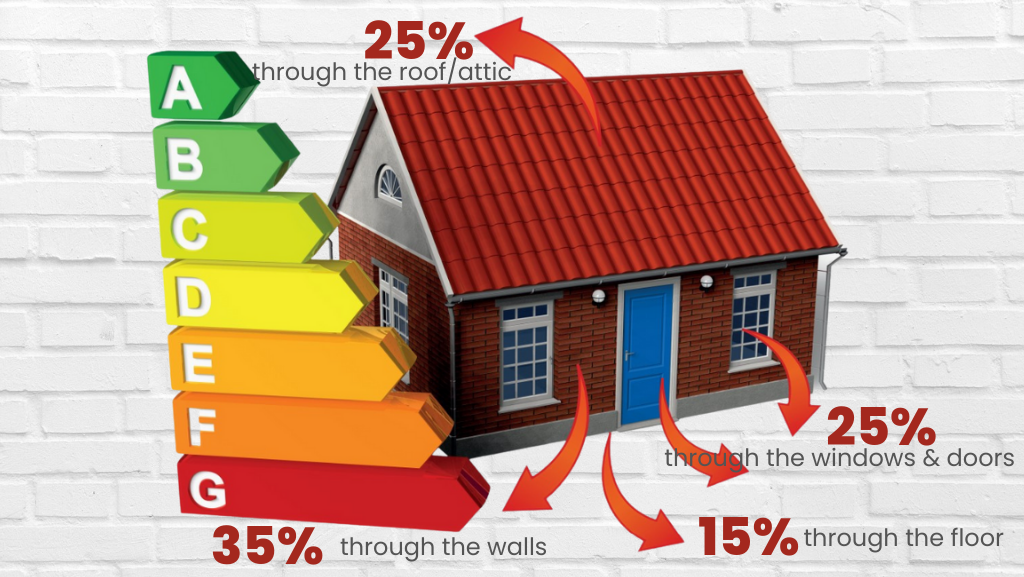Everything you need to know about double glazing, from the Build Magazine Best Double Glazing Company in Lancashire 2022!
Our double glazing experts have put together all of the questions we get asked about windows most often. From energy efficiency queries to practical questions, if you have a burning question about double glazing, you’re sure to find the answer here! You can also check out our Tips of the Trade Blog for all of our insider insights, from choosing a tradesperson to caring for your new home improvements.
What is Double Glazing?
Double glazing is a window that has two panes of glass. The main element of the window is the double glazed sealed unit, also known as an insulated glass unit (IGU) which sits in a frame of uPVC, aluminium or timber.
The IGU comprises of two sheets of glass separated by a spacer bar to create a gap or cavity which is filled with an insulating gas and sealed. The primary benefit of double glazing is thermal insulation – to retain heat in a room whilst stopping cold air entering from outside.
View Our Range of Double Glazed WindowsGlass is a fantastic conductor of heat & cold, so single glazed windows do very little to prevent the transfer of heat, whether it’s going in or out. This will mean that you end up overspending on heating and energy bills in the long run. Standard double glazing is effective because whilst glass is a good conductor of heat, air is not. The cavity between the two panes of glass creates a seal against the outdoors, reducing the transfer of heat. Staywarm Energy’s signature Maxitherm double glazed windows are filled with Argon gas, which conducts heat less well than air. Maxitherm insulated glazing units also come with a warm-edge spacer bar and a soft low emissivity coating, designed to prevent heat escaping through the windows to the cold outdoors in Winter – this also keeps it cooler in the summer by reflecting the heat out.
Staywarm Energy’s signature double glazing will give your home extra insulation. Did you know that a typical home loses 25% of heat from the windows and doors? Check out our blog post about where your house loses valuable heat. Single glazed windows are less than 10% energy efficient, meaning that 90% of the heat from your home and your heating is escaping through the windows! Even a standard modern double glazing unit with an argon gas filling is only around 70% – 80% energy efficient. Our signature Maxitherm insulated double glazing is up to 90% energy efficient when installed into uPVC frames, making the money you pay for your heating bills work as hard as it possibly can for you.
Yes, installing double glazing can save you money on your energy bills. As double glazing acts as an insulator (just like the foam or fibres from wall or loft insulation), it allows you to make the most of the money you spend on your heating bills, and prevent losing heat from your home. Many of our customers have been able to turn the heating down around 5 degrees, or have the heating on for less time, while the house stays warmer. Even if you already have double glazing that is 10 years old or older, Staywarm Energy double glazing can still save you money on your energy bills! Some of the thermal insulation technologies we use in our double glazed windows have only been developed within the past 10 years, so even if your windows are already double glazed, it is unlikely that they are as energy efficient as Staywarm Energy Maxitherm glazing.
With sustainability playing an increasingly important role in the housing sector, there has been more discussion around whether EPC ratings affect mortgages.
An EPC rating measures the energy efficiency of a property and when you are buying or selling a property, the person selling must show you the EPC. If you are wondering whether your EPC rate will affect your mortgage, you are right to! This is an increasingly important factor when considering which property to buy.
If you are buying a property for yourself to live in, mortgage companies will lend on properties with low EPC ratings. However, do expect them to make recommendations about potential improvements that could be made.
If you are planning to let out the property, it is important to know that is that it is now illegal to let any residential property with an EPC rating below E. So landlords will need to make improvements, such as insulation work, to improve any F or G rating.
An A-Rated window is the most thermally efficient window you can buy. The Letters you see in bands in Energy Ratings go from A – the most energy efficient – to G – the least energy efficient. You might see these energy ratings on insulation products – windows, doors, loft and cavity wall insulation – and on entire properties. Read more about Energy Ratings from the Energy Saving Trust.
The difference between A and A+ rated windows are that an A-rated window will only release as much heat as they let in from outside. An A+ rated window will let in more heat from the outside than it releases from the outside. So A+ rated windows will increase the ability to gain heat from the outside.

Solar gain is short wave radiation from the sun that heats a building, either directly through an opening such as a window, or indirectly through the fabric of the building.
Solar gain is a particularly effective form of passive heating, as radiation from the sun is predominately short-wave infrared radiation. This is able to pass through glazing and heat the internal fabric of the building. The long-wave infrared radiation that is re-radiated by the heated fabric of the building is not able to pass back out through the glazing. This results in heat accumulating in the interior, sometimes referred to as the “greenhouse effect”.
Very broadly, solar gain can be beneficial in cooler climates when it can be used as a passive way of heating buildings. However, too much solar gain can cause overheating.
A U-Value is a figure that represents the thermal transmittance of a building insulation product – that’s how much radiation (or heat) is lost through the material. U-Value is measured in Watts per metre squared (W/M²k). The U-Value scale is from 0 – 6; the lower the U-Value, the better the product insulates your home. U-Values correlated to the Energy Rating Letters you see in bands from A to G in an Energy Performance Certificate (EPC). Under current UK Building Regulations, the lowest allowable U-Value in a new construction is 1.8, or band C. The U-Value and Energy Rating will tell you how energy efficient your windows, doors or other insulation is, from A and A+ as the most energy efficient, and G as the least.
Our signature Staywarm Energy double glazing can also be made with a special acoustic glass. This can reduce up to 99% of external noise (when the windows are closed).
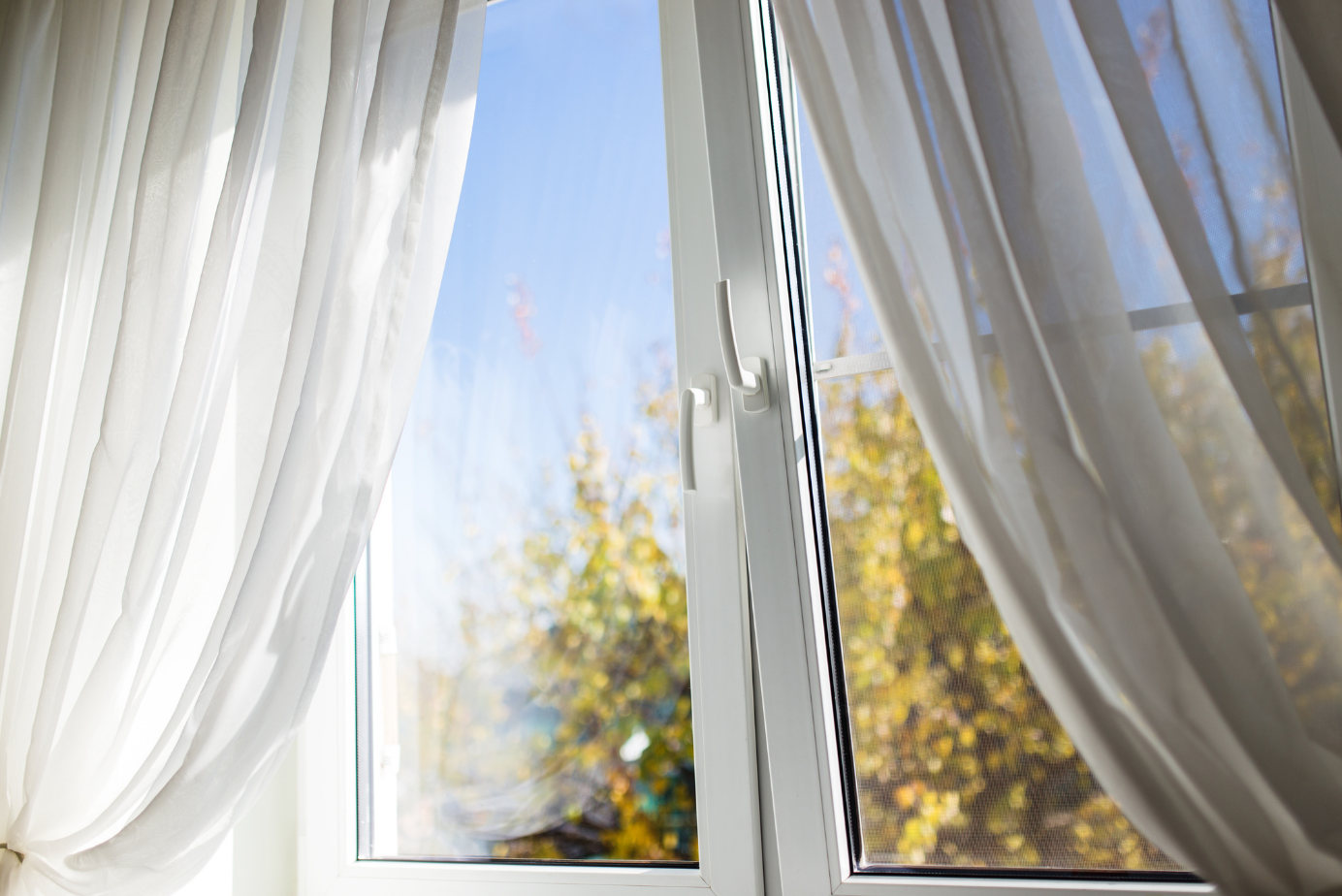
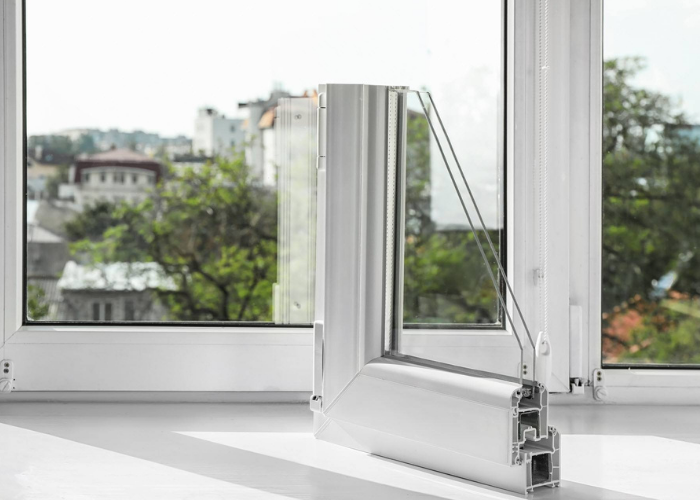

Triple glazing is made up of three panes of glass instead of one or two. The cavity or space between each pane of glass is filled with inert argon gas. Together with the extra pane, this can help to reduce noise transmission and increase energy efficiency.
Read Our Full Article About Triple Glazing!Triple glazing works so well for soundproofing because of the amount of layers the sound has to travel through. Each pane of glass weakens the strength of the sound wave. This means that by the time it does get through (if it gets through at all) it is much quieter and much less noticeable. The argon gas-filled cavities also help to slow the sound waves down.
However, our signature Staywarm Energy double glazing can also be made with a special acoustic glass. This can reduce up to 99% of external noise (when the windows are closed).
There are, however, some materials to avoid when thinking about installing triple glazing for soundproofing. Particularly in aluminium-frame windows, the extra cavity can actually have the effect of amplifying the sound. As always, we advise to choose a well-accredited, FENSA Approved company to ensure you are getting the best windows for your home and geographical location.
Read more in our Triple Glazing FAQs.
In most cases, triple glazing is the most energy efficient type of window you can get, making your home quieter and warmer. However, due to the weight of the three toughened glass panes, triple glazing may not be the best option for some properties. Read our full article about the Pros and Cons of Triple Glazing to find out more.
As triple glazing is more expensive than double glazing, it will take slightly longer for the savings in your energy bills to balance the cost of the materials and quality installation. However, triple glazing looks set to become the standard for new build homes and home improvements in the future, installing triple glazing can future-proof your home against potential changes in Building Regulations.
Triple glazing also adds a lot of value to your home! Energy Performance Certificates (EPCs) are becoming more and more important in buying and selling homes, with some mortgage providers even saying that a better EPC will start to affect mortgage rates in the near future.

Repairing and Replacing Double Glazing
You might not realise it, but your windows are one of the most used items in your home! The mechanical parts are in use nearly every day, so sometimes things do break or wear down and need replacing. In addition to this, glazing technology is constantly improving and being developed, making newer windows more energy efficient.
In most cases, it is quote obvious when you need to repair or replace your windows. If any of the glass has cracked, or frames are rotten or broken, you will need to replace your windows or frames.
If your frames are completely intact, it is possible to just change the glazing inside! Find out more about our energy efficient glass upgrades.
If you have condensation inside the window (in between the two panes of glass), then it’s time to replace the glazing at least! There are DIY hacks to fix condensation between the panes of glass, but we really don’t recommend them! Read our full article about blown or failed double glazing to find out more.
Double Glazing can lose its effectiveness if the seal fails. You can usually tell if this has happened if you see condensation in between the two panes of glass. This means that the sealed double glazed unit has failed or blown. Find out more about Blown Double Glazing.
If your windows are over 10 years old, it’s likely that you can improve the energy efficiency of your home by upgrading to newer double glazing. The energy efficiency technology used in double glazing does develop over time, and you may be able to increase the energy efficiency of your windows by up to 30% by upgrading to the latest technology.
Our Staywarm Energy signature insulated double glazing is up to 90% energy efficient when installed into uPVC frames! Find out what makes it so special in our video below!
How often you replace your double glazing really depends on the quality of the products used and the skilfulness of the installation. As with so many things in life, you really do get what you pay for. Some companies will scrimp on quality to give you a cheaper price – but in many cases this is a false economy, as you will need to replace the glazing more frequently.
We are so confident in the quality of our Maxitherm insulated double glazed units that we offer a lifetime guarantee on glazing installed into uPVC frames… that’s right, a LIFETIME!
Our double glazed windows come with a minimum 10 Year Insurance Backed Guarantee as standard. When we are installing our Maxitherm+ units into uPVC frames, we offer a Lifetime Guarantee on the double glazing!
Quality Over Price
Since upgrading your windows to double or triple glazing is an investment in your home, it really isn’t something you can scrimp on. Especially with installing triple glazing, you really do need to ensure that you are choosing the best quality you can find.
You should always choose a properly accredited company to ensure that your installation complies with building regulations, is registered with the local authority and comes with a quality guarantee.
Staywarm Energy are FENSA Approved Installers, and accredited by Trustmark and Fair Trades. We have also passed the full enhanced vetting procedures for Rated People and Checkatrade!
We offer a wide range of market-leading guarantees, ranging from our 10 Year Insurance-Backed standard guarantee to a full lifetime!

Even if you already have double glazing that is 10 years old or older, Staywarm Energy double glazing can still save you money on your energy bills! Some of the thermal insulation technologies we use in our double glazed windows have only been developed within the past 10 years, so even if your windows are already double glazed, it is unlikely that they are as energy efficient as Staywarm Energy Maxitherm glazing.
Condensation on the room-facing side of your double glazing means there is a ventilation problem within that particular room that needs addressing. You can also get condensation on the inside of the units when clothes are being dried in a room when it is cold and wet outside. Condensation on the exterior means the double glazed unit is performing exactly as it should and you will notice it disappear throughout the day as the sun rises. This phenomenon is a natural occurrence and not a fault with the glass or the window, and is not due to your double glazed window failing as described above. The situation occurs mainly in Spring and Autumn, when the glass temperature falls to a low level at night, with the moisture of a heavy morning dew condensing against the cold surface of the glass.
No, there should not be anything other than the clear argon gas in between the panes of glass in your double glazing. If there are droplets of water or any other material, this means that the seal on the double glazed unit has failed, and the window will have lost much of its insulating properties.
When the seal on the double glazed unit breaks down (or “fails” as is known in the industry) that condensation will get into the inside of the glass unit, resulting in misted or blown double glazing. If the seal is broken, then air can seep inside. Air contains microscopic droplets of water, which is what you see forming as condensation between the panes of glass. Read more about blown double glazing here.

Adding Double Glazing For Security
Alongside doors, windows are a vulnerable point of entry to your home for intruders. 20% of burglars break into a house through the window which makes it essential to have robust window security.
Installing secure windows that meet accredited standards will help to protect your home from intruders and should be as standard for ground-floor windows.
Newer double glazing is difficult to break into, and can even act as a burglar deterrent, as it has 2 panes of glass to break through.
The elements that make our double glazed windows super-secure are:
- Internal beading
- Multi-locking points
- Steel reinforced frames
- Key-lockable handles
- Laminated glass
The glazing in your windows is held in place by a special strip called a bead. Many years ago, the original uPVC windows had the beads on the outside of the frame, making it easy for burglars to remove it, pop the double glazed unit out and gain entry to your property!
All of our Staywarm Energy windows are internally beaded, meaning that an intruder would already have to be inside the house to remove the beads and glazing.

Double Glazing & My Lovely Home
Over the years, double glazing has developed significantly, meaning that there are many different options to suit virtually every home. Gone are the days when double glazing meant white chunky frames that often spoiled the aesthetics of the house. With timber-effect uPVC, flush profile frames and a huge range of colours and finishes to choose from, we can even upgrade your windows to double glazing in most Listed properties and Conservation Areas.
Absolutely yes, ensuring your windows and doors are energy efficient will add value to your home. Energy Performance Certificates (EPCs) include information about the property’s energy use and costs as well as recommendations about how to make a home more energy efficient and cheaper to run. Properties are ranked from A to G, A being the most energy efficient. As of April 2018 properties ranked F or G will not be allowed to be let to tenants. As such rating will be especially important to landlords looking to buy a property to let.
Money Supermarket published a report in September 2022, stating that:
“Based on average property prices in England we are able to see a correlation between a stronger energy efficiency rating and a higher house price, the graph below highlights the price increase as a result of raising your EPC from a G rating through to a higher A ratings, where property value can be as much as 14 per cent higher.”

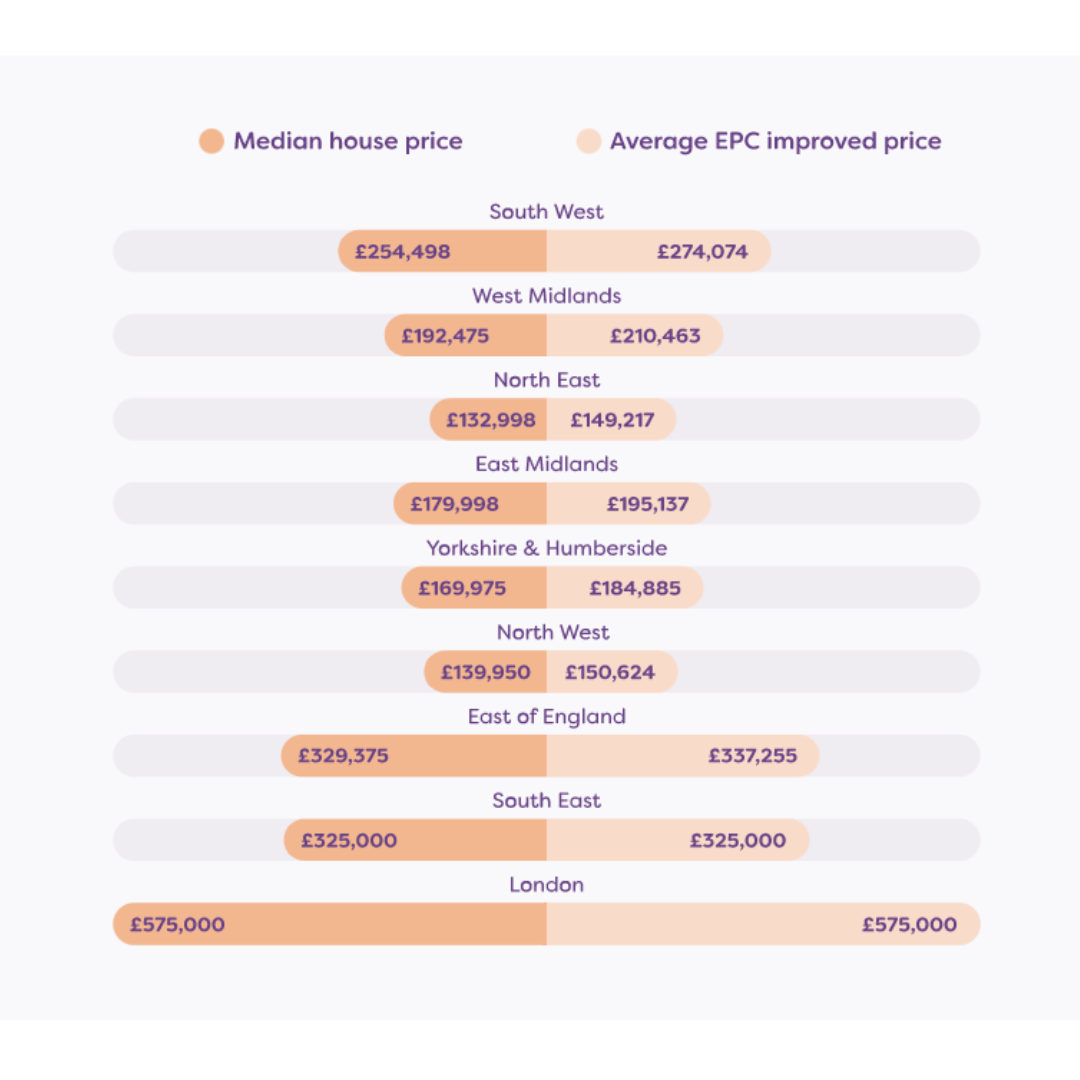

Our uPVC windows come in a range of standard colours, but can also be bespoke made for you in over 200 RAL colours! View the RAL Colour Chart.
Our timber windows come in solid, sustainable sapele hardwood, and can be stained or painted in any colour you like!
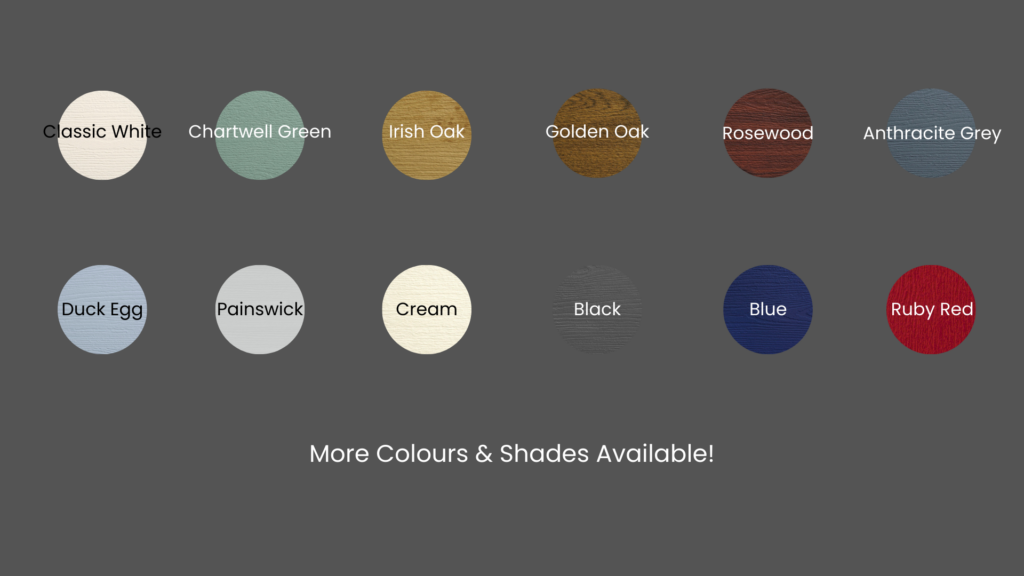
Yes, coloured uPVC windows typically cost around 5% – 10% more than white uPVC windows.
uPVC spraying is where a spray-on colour is applied to your existing window frames, without removing them from your house. Homeowners usually choose this option to give new life to old frames, however this can cause a LOT of problems!
Given that uPVC spraying involves using your existing frames, any imperfections, wear and tear and residual dirt will be underneath the spray coating, and will show up in the finished article. As the windows are not removed from the home for spraying, the coating is not applied in a controlled environment, meaning it is at the mercy of the Great British weather. All of these factors usually lead to the sprayed coating flaking and peeling very quickly.
The colours in our new coloured uPVC frames are fully foiled in a controlled environment, using a heat-bonding process onto virgin uPVC, meaning the colour becomes an integral part of the frame rather than a sprayed coating.
Unless you live in a Listed property or a property within a Conservation area, you can have pretty much any window style according to your taste and personal preferences. Older homes tend to suit the more traditional sash window styles, while newer properties will tend to suit a more modern style such as a casement or tilt & turn window.
Properties in Conservation areas and Listed buildings tend to have covenants on the property stating that building fabric such as window frames and doors need to be replaced like for like. If you are unsure, just give us a call! Our energy advisors have helped many customers over the years with requirements for particular properties and how to make older homes more energy efficient!
View Our Window StylesNot always! If you are replacing the window frames, there will be a fair amount of mess during the removal of the old windows and installation of the new ones. If you are adding a new window where there wasn’t one before, or changing the size of a window or window frame, the work involved in changing the brickwork will cause some mess. However, a quality tradesperson should always leave your home clean and tidy once the installation has finished! Our engineers pride themselves on keeping your home as clean, tidy and mess-free as possible. We also offer a full service, right down to the finishing touches, which can include re-plastering or re-trimming around the new window.
In some cases, you can get considerable energy savings by upgrading the glass and keeping your frames.
Find Out More About Our Glass UpgradesWhether or not you need to replace the window frames instead of just the glass inside them will dictate whether you need to redecorate.
When changing the glass within the frames alone, it is highly unlikely you will need to redecorate… unless you want to! As the frames are never removed in this process, there should be no damage at all to the interior or exterior of your home.
If you are replacing the window frames, adding a window where there wasn’t one before or changing the size of the window or frame, you may need to do some finishing touches once the installation is finished. Our full service package includes the finer details such as plastering or trimming up.
On average, each window takes anything from an hour to 3 hours to install. The time it takes to install the window will be different depending on the size and type of window.
Our uPVC windows come in a variety of fully foiled timber-effect finishes, but for a true alternative to timber (even in some Conservation areas), we offer Residence Collection frames. The Residence Collection was created with the enduring designs of British architecture in mind and has many bespoke options that can satisfy a range of homes, from the grandeur of stately homes to the solid good looks of Georgian and Victorian properties, right through to present-day abodes.
The collection uses copied historical design and considered conservation guidelines, which authentically replicate traditional timber sightlines. You’ll immediately notice the benefits of the thermally efficient multi-chamber design and modern glazing, whilst retaining the character of your home.
Energy efficient double glazed frames are usually made of either timber or uPVC. Frames are also available in aluminium, but as metal is an excellent conductor of heat and cold, aluminium windows have a higher U-Value than timber or uPVC, meaning they are less energy efficient.
There’s no surprise that uPVC has been one of the nation’s most popular choices of window frames for many years. It’s a versatile and reliable material that requires minimal maintenance. Our energy efficient uPVC windows are our most popular options, with a wide range of colours, finishes, styles and decorative glass options to make a real visual impact.
Traditional wooden window frames are fantastic for keeping the history and character of a building. The unique finish and time-honoured designs are hard to match in terms of quality, especially when it comes to Listed buildings and homes in Conservation areas. When sourced responsibly, timber is one of the most environmentally friendly building materials – the timber window frames even help to capture CO2 from the surrounding atmosphere. Wooden window frames also offer the lowest thermal conductivity of any frame material, giving you that extra layer of insulation for your home.

Double Glazing For Listed and Heritage Properties
Absolutely not! We have a wide range of options for installing double or triple glazing into heritage properties, even with keeping your existing frames.
We can repair and rebate original timber frames for double glazing, so that you can keep your heritage frames. Read our article about rebating frames for double glazing.
We are also one of the only companies in the North West to create bespoke new timber frames by hand. Our stunning new wooden window frames are hand-crafted in sustainable sapele hardwood, using traditional joinery techniques instead of machine cutting and screwing or gluing.
In most cases you do not need to change your window frames; upgrading the glazing is just as effective and can dramatically increase the efficiency of your home whilst reducing heat loss and cost. We install our ‘Maxitherm+ Insulated glass units’ high performance glazing as standard.
Find Out More About Maxitherm Insulated GlazingIn most Listed buildings and properties, you will need to replace any building fabric such as windows, frames, doors and brickwork like for like – meaning that if you have timber window frames, it’s likely you will need to replace them with new timber window frames.
However, a more modern approach has been for planning authorities to approve the use of The Residence Collection in conservation areas because of its authentic design. It has been specifically designed to aesthetically replicate the documented historical window designs from the 19th Century period and therefore has been approved for use in many areas across the UK.
The Residence Collection offers a suite of thermally and acoustically superior window and door systems, featuring the latest security, maintenance and performance innovations, whilst still appearing traditional. Achieving U-values of 0.8 with triple glazing and 1.2 with double glazing, far surpassing the British Building Regulation requirements.
Wooden window frames also offer the lowest thermal conductivity of any frame material – they are actually even less conductive than uPVC!
Our timber windows are our most environmentally friendly window frames. The sustainably sourced sapele hardwood that we use lacks permeability, meaning that it is very difficult for water to seep in, even without the weatherproof primer we use to prevent rot. Timber window frames also help to remove carbon dioxide from the atmosphere, helping the climate and reducing your carbon footprint.
Unless you live in a Listed property or a property within a Conservation area, you can have pretty much any window style according to your taste and personal preferences. Older homes tend to suit the more traditional sash window styles, while newer properties will tend to suit a more modern style such as a casement or tilt & turn window.
Properties in Conservation areas and Listed buildings tend to have covenants on the property stating that building fabric such as window frames and doors need to be replaced like for like. If you are unsure, just give us a call! Our energy advisors have helped many customers over the years with requirements for particular properties and how to make older homes more energy efficient!
View Our Window StylesYes, we can create double or triple glazed windows using your original leaded window panes.
Generally the most popular option among our customers is to encapsulate the leaded glass pane inside a double glazed unit, protecting the heritage glass from the elements and creating a highly energy efficient triple glazed window that will save you money on your energy bills.
If your leaded window panes are beyond repair, or in need of a refresh, we can replicate the original designs and create double or triple glazed windows with them.
Yes, we can create double or triple glazed windows using your original stained glass window panes.
Generally the most popular option among our customers is to encapsulate the stained glass pane inside a double glazed unit, protecting the heritage glass from the elements and creating a highly energy efficient triple glazed window that will save you money on your energy bills.
If your stained glass window panes are beyond repair, or in need of a refresh, we can replicate the original designs and create double or triple glazed windows with them.
Do you have leaded or stained glass windows that are in need of some love? Or beautiful but draughty single glazed panes?
Staywarm Energy can help! We offer a stained and leaded glass restoration and encapsulation service to make your heritage windows shine again!
The original panes are either lovingly hand-restored, or skilfully re-created and aged. Then the detailed pane is encapsulated inside one of our signature Maxitherm insulated glazing units, making a highly energy efficient triple glazed window!
This process also adds an extra layer of security into your windows! By the simple fact that it has 3 full panes of glass, triple glazing is much harder to break into than single or double glazing. Just the sight of triple glazed windows can act as a powerful burglar-deterrent.


